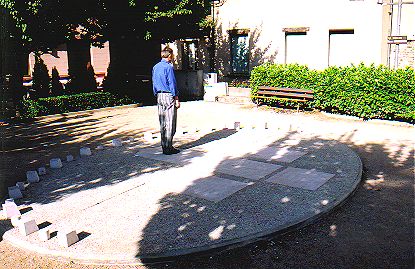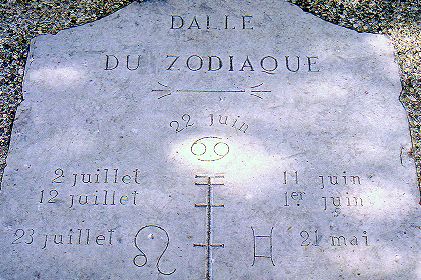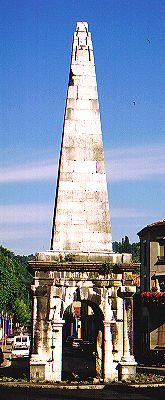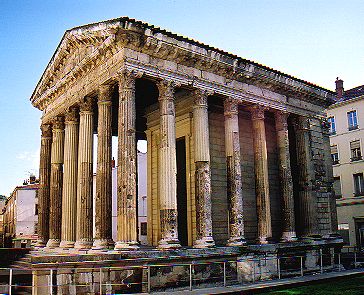
Analemmatic dials
Vienne (Isère, France)

This dial can be found in the very center of Vienne, on the corner of the Rhône boulevard and the square in front of Saint-Maurice cathedral. The major axis is 6.0 m (20 ft), a fair size. The square stubs carry the hour numbers, from 5 to 19 hr local time. Round half-hour stubs in between. The foci of the ellipse are also indicated, which is not very common. Except for the latter feature, this dial closely resembles the one in Avignon.

The date line is nicely engraved in a large slab of stone. Divisions are per 1/3 month; the signs of the zodiac are included. The stone to the left (west side) relates the instructions for use. The stone below the date line mentions the designer: Bonnet de Villario, the years of construction (1938) and restoration (1994) and the coordinates. The longitude is given relative to the Paris meridian. Odd, though, as the Greenwich meridian was adopted world-wide already in 1884. Paris is about 2°20' east of Greenwich.
The right-hand stone enables the conversion to civil time. It shows two tables, one for regular time (date range 27 March - 9 October) and one for daylight saving time (2 October - 27 March). The values looked rather odd to me: in summer the dial would be slow by half an hour to three quarters, in winter it would be fast by a quarter to half an hour! When I calculated the time zones that fitted these data, the puzzle was solved: GMT in winter, Central European Time in summer. France used GMT before World War II. But why, then, state the longitude with respect to the Paris meridian?
It seems that the dial is not correctly oriented. At 18:00 (DST) the local apparent time is about 16:25. However, the dial read 16:00 hr sharp. That implies that it should be rotated counterclockwise by about 5°.
Location: 45.5° N, 4.9° E
Design: Bonnet de Villario
Inauguration: 1937
We would not normally make a stop in Vienne, which is just south of Lyon in the Rhône valley. Once past Lyon, we would not stop until we saw the Mediterranean, or at least smelled the fragrances of the Provence.
 |
 |
Wrongfully so. The city was a surprise. Lots of Roman remains, of which we visited only two: the "Pyramid", the eye-catcher of the former Circus, in the southern quarter and the temple of Augustus and his wife Livia, once part of the Forum and now right in the city center.
Would the "Pyramid" ever have served as a nodal dial, like the sundial of emperor Augustus in ancient Rome?